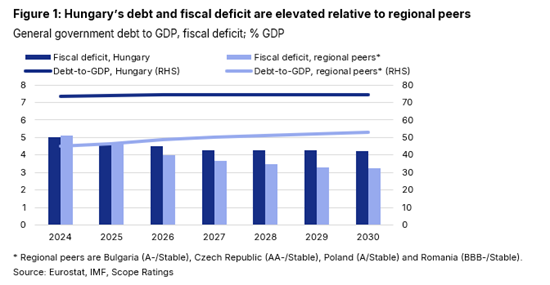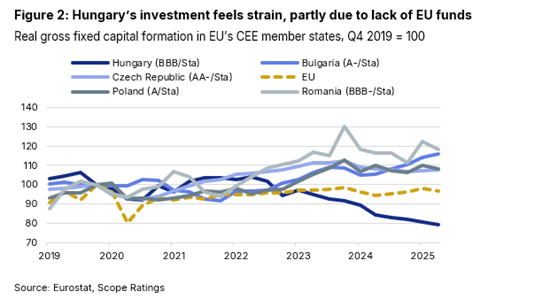Announcements
Drinks
Hungary: fiscal outlook hinges on economic recovery and spending discipline
By Julian Zimmermann, Sovereign and Public Sector
Hungary’s (BBB/Stable) fiscal outlook remains challenging with a relatively elevated general government debt level at 73.5% of GDP in 2024. We project the debt ratio will remain stable in the medium-term, underpinned by a broadly balanced primary fiscal position and high nominal GDP growth (Figure 1).
The 2024 general government budget deficit of 5.0% of GDP was a marked improvement from 6.8% in 2023, underpinned by a narrowing of the primary deficit to just 0.1% of GDP.
However, high interest expenditure – driven by inflation-linked retail bonds – continues to strain public finances. Although inflation-linked costs will decline this year, the interest payments will remain structurally high at an average 4.3% of GDP between 2026 and 2030.

Only moderate economic growth has complicated stronger fiscal consolidation
We forecast a further reduction in the fiscal deficit in 2025 to 4.7% of GDP, above the government’s latest 4.3% projection. This partly reflects continued economic weakness. After a contraction in real GDP of 0.8% in 2023 and a modest recovery of 0.6% in 2024, we expect growth of just 0.6% this year. In 2026, growth should be more robust at around 2%.
The likely wider-than-expected fiscal deficit also reflects the impact of measures such as the expanded family tax allowance and subsidised loan programmes. While sectoral windfall taxes – e.g., on banking and energy –will continue to underpin revenues, they are no substitute for more comprehensive fiscal reform. We expect the fiscal deficit to only gradually decline to 4.2% of GDP by 2030.
Weak investment represents the main drag on economic performance amid suspended EU funds
Hungary’s governance challenges lead to persistent uncertainty on EU funds and associated investments. The country has only partial access to EU Cohesion funds and has received minimal disbursements under the Recovery and Resilience Facility and RePowerEU allocations: EUR 6.4bn in grants and EUR 3.1bn in loans remain suspended, together equivalent to around 4.6% of GDP.
Uncertainty on EU funds has contributed to a sharp decline in aggregate investment. Real gross capital formation was only 80% of its end-2019 level in Q2 2025 (Figure 2), well below its peers. This represents a significant drag on economic performance and increasingly weighs on Hungary’s economic growth potential.
 Hungary’s external profile remains robust, but dependency on Russian energy remains high
Hungary’s external profile remains robust, but dependency on Russian energy remains high
Externally, the resilience of Hungary’s relatively small, open economy is robust and has improved but remains constrained by its reliance on trade with the rest of the EU and its heavy dependence on foreign capital and energy imports. Around 74% of total gas and 86% of total oil imports were from Russia in 2024 according to the IMF.
The automotive and manufacturing sectors rely heavily on external investment, making the country vulnerable to shifts in global sentiment.
In this context, safeguarding economic and external buffers to withstand further potential global trade, energy and geopolitical risks is critical.
We affirmed Hungary’s credit rating at BBB with Stable Outlook on 10 October 2025.







